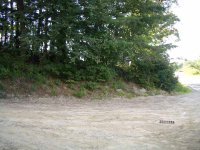</font><font color="blue" class="small">( It would sure be nice to see a picture of the proposed road area. )</font>
Here is a picture of the existing driveway (17% grade) up the front. The state requires that the first 20' be level, and then put in a couple switchbacks to lower the slope to 12%. All the trees in this picture will be taken out to allow for sitework. The steep parts are on both sides of the driveway.
Here is a picture of the existing driveway (17% grade) up the front. The state requires that the first 20' be level, and then put in a couple switchbacks to lower the slope to 12%. All the trees in this picture will be taken out to allow for sitework. The steep parts are on both sides of the driveway.





